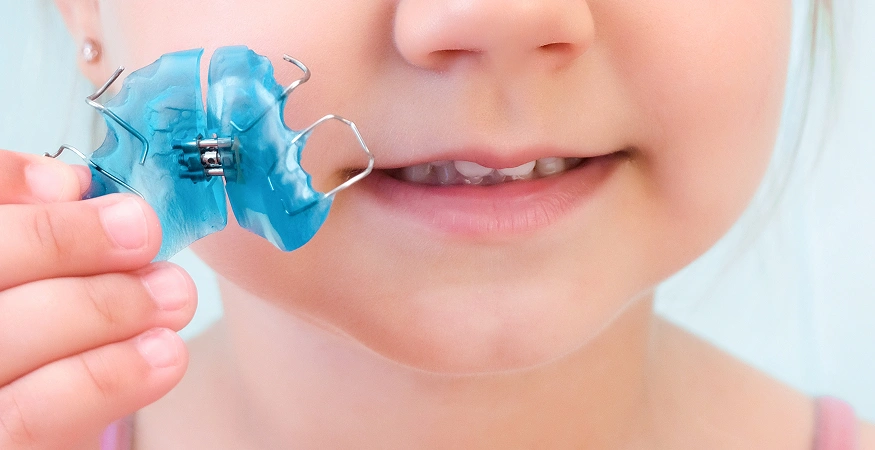Now the common question that you may think is, is TMD curable? Well, yes, it is! TMJ disorders are curable and treatable. There are special tools called occlusal Splints (orthotics) for TMJ to relieve you from jaw discomfort. In this blog, you will learn what occlusal splints are, their various types, the difference between night guards and occlusal splints, and how they cure jaw pain. Let’s dig in!
Now that you know what occlusal splints are. It’s time to take a closer look at the types of splints for TMJ:
These are the regular splints you receive from a conventional dentist as a nightguard. Soft splints are manufactured from flexible materials and give a cushioning impact to mitigate symptoms connected to clenching or grinding. They are very comfortable and convenient to wear, and their level of support and steadiness is different from that of rigid splints. They don’t actually help in treating the TMD but does provide symptomatic relief temporarily.
Also called anterior deprogrammers, partial coverage splints only cover the front teeth to prevent the back teeth from touching their front counterparts. As a result, an unstable bite is created while reducing muscle activity in the jaw. Hence, even though it may provide temporary relief, in the lon run, it will lead to neck pains.
Also called permissive TMJ occlusal splints, they are created to support and stabilize the jaw joint. They fix the bite problem temporarily and allow your jaw to find its correct position temporarily. Permissive splints do not encourage proper bite alignment in the long term. They are comfortable to wear, and orthodontists suggest stabilization splints for temporary management of TMJ disorders.
Also known as orthotic or non-permissive splints, they are created to guide the jaw into a fixed position. An anatomic neuromuscular orthotic fabricated based on a bilaterally TENS induces muscle friendly bite is a very good example of a reprogramming repositioning splint. Repositioning splints consists of inclined surfaces and ramps that cure misalignments or malocclusions in the bite. They are one of those types of splints for TMJ that are specially customized to fit your jaw. They aim to reposition the jaw joint and mitigate TMJ disorder.
Occlusal splints serve many purposes to cure and treat TMJ disorders. Below is how a TMJ occlusal splint eases pain in the jaw area:
One of the most important functions of occlusal splints is to create a steady balanced bite. These appliances cure stress on the temporomandibular joint and the muscles around it. Splints cure unbalanced jaw pressure, promote a balanced force distribution when you bite and chew your food, and maintain your upper and lower teeth right alignment
TMJ occlusal splint is a physical horizon between your upper and lower teeth, promoting jaw muscle relaxation. As a result, the stress of grinding and clenching is decreased considerably, letting your jaw muscles rest properly and reducing soreness and stiffness on the muscles.
Teeth protection and any dental restoration like crowns or fillings are one of the main benefits of using an occlusal splint. It can decrease tooth wear and strengthen the longevity of teeth restorations.
A TMJ occlusal splint motivates balanced jaw alignment, which leads to a smooth and more comfortable jaw movement. Rightly aligned jaws facilitate speaking, chewing, and opening your mouth widely without pain, stress, or discomfort.
Occlusal splints for TMJ and night guards are two different appliances. Now, it’s time to understand the difference between occlusal splints vs night guards. TMJ splints are personalized tools designed to fix your bite problems from your teeth impressions. They cover your upper and lower teeth. These tools limit jaw movement and motivate balanced jaw alignment. They support and stabilize your joint, which helps your jaw and muscles near your jaw relax and decrease strain and pain. TMJ splints decrease jaw joint pressure and are mainly used to relieve you from TMJ discomfort and pain.
On the contrary, night guards are tools that safeguard your teeth from grinding. When comparing occlusal splints vs night guards, they are tailored to your teeth impressions, but they are simpler than splints. Night guards do not limit movement in your jaw area, but act as a boundary between your upper and lower teeth and safeguard the structure of your teeth.
Splints are highly successful and effective in managing pain in the jaw area and related to temporomandibular joint disorders. Before using such appliances, patients often encounter discomfort and pain, which can substantially influence daily life and overall oral health. When assessing the effect of an occlusal splint before and after usage the difference in your comfort and managing discomfort is noticeable:
To treat the most complex of TMJ problems, contact us at TMJ India and get your appointment with our TMJ experts today!






